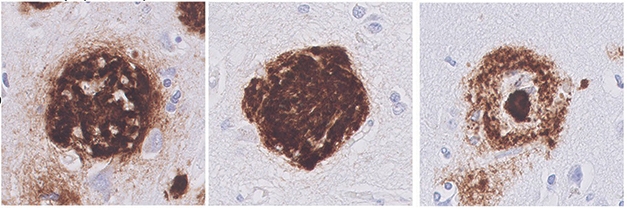You’d think that by 2020, pathologists would know all about what amyloid plaques look like? Well, no. Researchers led by Jeroen Hoozemans at Amsterdam University Medical Center have characterized what they believe to be a distinct type. As reported in the September 14 Acta Neuropathologica, these “coarse-grained plaques” can be large and complex structures. At first glance they look similar to the wispy cotton-wool plaques, but they pack tighter and have voids of Aβ in the center. In this regard, coarse-grained plaques also differ from the classic dense-core plaques. Coarse-grained plaques comprise mostly Aβ40, which, in the largest specimen, forms a shell around an Aβ42 core.
- The coarse-grained kind are distinct from other amyloid plaques.
- They abut blood vessels.
- People with early onset AD and ApoE4 have more of them.
Sidling up to blood vessels and packed with norrin, a marker of blood-vessel damage, these plaques are more common in people who carry two copies of the ApoE4 allele or who have early onset Alzheimer’s disease.
“This paper highlights the fact that Alzheimer’s disease is not the same in every case,” said Costantino Iadecola, Weill Cornell Medical College, New York. “It fits with AD being more of a disease spectrum that is influenced by genetics, ApoE status, hypertension, and other vascular risk factors.” Dietmar Thal, KU Leuven, Belgium, agreed. “This study importantly supports the concept of subtypes of AD that differ in their morphological, genetic, and clinical characteristics,” he wrote to Alzforum (see comment below).

Variation on a Plaque. Coarse-grained plaques (left) lack the clearly delineated borders of the cotton-wool plaques (center) and the compact centers of the dense-core plaques (right). [Courtesy of Boon et al., Acta Neuropathologica 2020.]
Indeed, the authors believe that, like the amyloid deposits found in cerebral amyloid angiopathy (CAA), coarse-grained plaques have a vascular origin. “Whereas CAA occurs when Aβ40 travels across the blood-brain barrier and gets stuck in the blood vessels, coarse-grained plaques may form when Aβ fails to cross the barrier and gets stuck outside the vessels,” first author Baayla Boon told Alzforum.
Read the article in full on the Alzforum website – https://www.alzforum.org/news/research-news/introducing-coarse-grained-plaque-new-type-amyloid

 Print This Post
Print This Post





